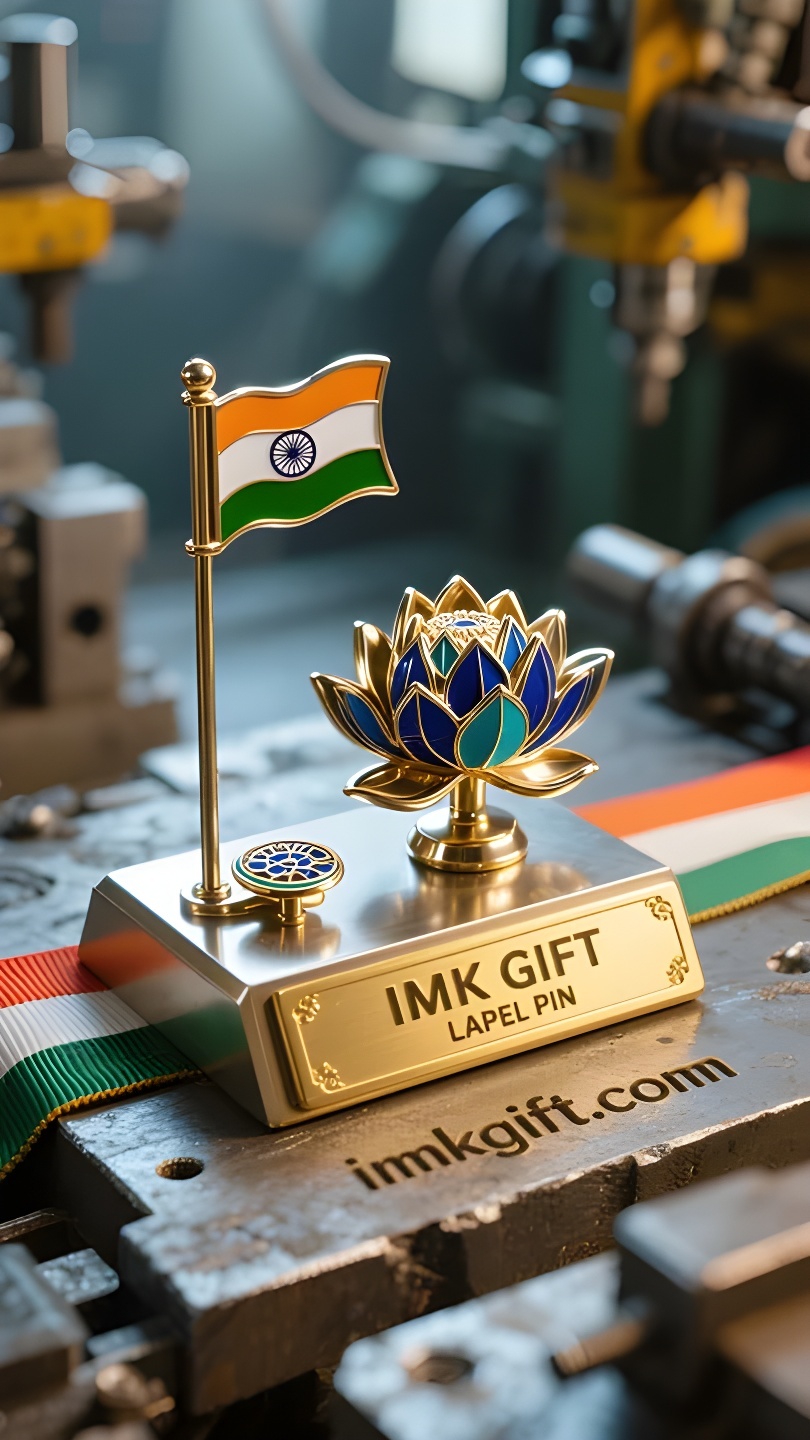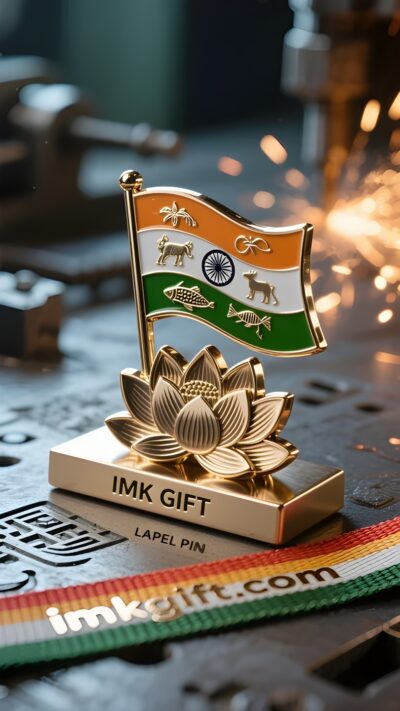in985-ल-टस-प-परव-ट-और-व-ह-ल-ऑफ-इ-ड-य-स-थ-रत-म-ख-लत-सभ-यत-क-र-शन
▼
भारतीय ध्वज पर गहरे नीले रंग का धर्म चक्र, अपनी 24 तीलियों के साथ, शाश्वत आगे की गति का प्रतीक है; जबकि कमल के आकार का सामान्य कांस्य पेपरवेट, उड़ते हुए पन्नों को स्थिर मुद्रा में थामे रहता है। ये दो असंबंधित वस्तुएं मिलकर उथल-पुथल के बीच एक प्राचीन सभ्यता के जीवित बचे रहने की बुद्धिमत्ता की कहानी कहती हैं। कमल पेपरवेट की ढलाई की प्रक्रिया हजारों वर्षों से चली आ रही है। शिल्पकार प्रवाहित धातु को पिघलाकर एक स्थिर आधार बनाते हैं, ठीक वैसे ही जैसे हिंदू धर्मग्रंथों में “गति में स्थिरता की खोज” का दर्शन है। जब तेज हवा डेस्क पर बहती है, तो पेपरवेट कमल के आकार में पहरा देता है। पंखुड़ियों का वक्र मंडल की पूर्णता को प्रतिध्वनित करता है, और आधार का गुरुत्वाकर्षण वैदिक युग के ब्रह्माण्ड विज्ञान को मूर्त रूप देता है – केवल एक ठोस आधार ही सभ्यता के लेखन को अस्थायित्व के सामने सुरक्षित रख सकता है। राष्ट्रीय ध्वज के मध्य में स्थित “अशोक धर्म चक्र” दिन-रात घूमता रहता है तथा इसकी 24 तीलियाँ उपनिषदों में वर्णित उन 24 सद्गुणों के अनुरूप हैं जिनका मनुष्य को पालन करना चाहिए। निरंतर घूमता हुआ पहिया और स्थिर पेपरवेट एक अद्भुत प्रतिध्वनि उत्पन्न करते हैं: पहला हमें प्रौद्योगिकी और समय की बढ़ती उन्नति की याद दिलाता है, जबकि दूसरा नैतिकता और परंपरा की अडिग नींव का प्रतीक है। जिस प्रकार भारत ने आधुनिकीकरण की लहर में शरीर और मन को संतुलित करने के लिए हमेशा योग दर्शन का उपयोग किया है, तथा विभाजन को समाप्त करने के लिए जाति सुधार का उपयोग किया है, जिससे प्राचीन ज्ञान को समाज को स्थिर करने के लिए “सभ्य पेपरवेट” बनने की अनुमति मिली है। जैसा कि भारत अपना 77वां स्वतंत्रता दिवस मना रहा है, प्रत्येक नागरिक को देश का “जीवित पेपरवेट” होना चाहिए – एक कमल की तरह जो बिना दाग लगे कीचड़ से निकलता है, और एक कांस्य की तरह जो सत्य की रक्षा करता है। जैसा कि टैगोर ने कहा था, “जीवन मोमबत्ती नहीं है, बल्कि प्रकाश देने वाला दीपक है।” इस उपमहाद्वीप में शाश्वत धर्म चक्र और मजबूत पेपरवेट मिलकर सभ्यता की विरासत का ताना-बाना बुन रहे हैं।
The dark blue Dharma wheel on the Indian flag, with its 24 spokes, symbolizes the eternal forward movement; while the common lotus-shaped bronze paperweight, which is common among the people, holds up the flying pages with a calm posture. These two seemingly unrelated objects, together tell the survival wisdom of an ancient civilization in the midst of turmoil. The casting craftsmanship of the lotus paperweight has been passed down for thousands of years. Craftsmen melt the flowing metal into a constant base, just like the philosophy of “seeking stillness in motion” in Hindu scriptures. When the wind sweeps across the desk, the paperweight guards one side in the shape of a lotus. The curve of the petals coincides with the perfection of the mandala, and the gravity of the base condenses the cosmology of the Vedic era – only a solid foundation can protect the writing of civilization in the impermanence. The “Ashoka Dharma Wheel” in the center of the national flag rotates day and night, and the 24 spokes correspond to the 24 virtues that humans should follow in the Upanishads. This perpetually moving wheel and the static paperweight form a wonderful resonance: the former reminds us of the rush of science and technology and the times, while the latter symbolizes the unshakable foundation of morality and tradition. Just as India has always used yoga philosophy to balance the body and mind in the wave of modernization, and used caste reform to eliminate divisions, so that ancient wisdom can become a “civilized paperweight” to stabilize society. As India welcomes its 77th Independence Day, every citizen should be a “living paperweight” of the country – like a lotus that emerges from the mud without being stained, and guards the truth with the quality of bronze. As Tagore said: “Life is not a candle, but a lamp holding light.” On this subcontinent, the eternal Dharma wheel and the stable paperweight are weaving the warp and weft of civilization inheritance.
印度国旗上的深蓝色法轮,以24根辐条象征永恒向前的律动;而民间常见的莲花状青铜镇纸,则以沉稳之姿托起纸页的飞扬。这两件看似无关的物件,却共同诉说着一个文明古国在激荡中的生存智慧。
莲花镇纸的铸造工艺传承千年,工匠们将流动的金属熔铸为恒定的基底,恰如印度教典籍中”动中求静”的哲思。当狂风席卷书案,镇纸以莲花之形镇守一方,花瓣的曲线暗合曼陀罗的圆满,底座重力凝聚着吠陀时代的宇宙观——唯有根基稳固,方能在无常中守护文明的书写。
国旗中央的”阿育王法轮”日夜旋转,24根辐条对应着《奥义书》中人类应遵循的24种美德。这永动的轮盘与静止的镇纸形成奇妙共振:前者提醒着科技与时代的奔涌向前,后者则象征着道德与传统的不移根基。正如印度在现代化浪潮中,始终以瑜伽哲学平衡身心,用种姓改革消弭割裂,让古老智慧成为稳定社会的”文明镇纸”。
当印度迎来第77个独立日,每个公民都应是国家的”活态镇纸”——既如莲花般出淤泥而不染,又以青铜之质守护真理。正如泰戈尔所言:”生命不是蜡烛,而是举着光明的灯盏。”在这片次大陆上,永恒的法轮与稳固的镇纸,正共同编织着文明传承的经纬。
▼
Contact Us
📞 Tel: +0086-760-85286839
📧 Email: sales3@imkgift.com








